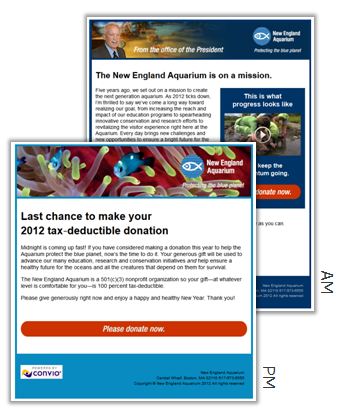Donors afford the causes they support a great deal of leniency on December 31st. After all, it is the biggest fundraising day of the year. But even then, that right should not be abused.
The spray-and-pray approach to email communication is slowly (though I'd argue at times, too slow) becoming a thing of the past. Organizations are getting smarter about email communication and seeing advanced segmentation strategies, often at the expense of increased number of messages, becoming the new norm. The San Diego Zoo is a good example.
However, if there is one day of the year that every constituent on your file should be communicated to its December 31st – and, yes, especially the lapsed donors and inactive subscribers. This may be the one exception to your evolving segmentation strategy, but don't stop there.
Competition is stiff at year-end; you know it and your donors know it. This is why there is some leniency from donors, but one tactic to dive a bit deeper on the last day of year is to target a second message later in the afternoon. Yes, two emails in one day.
A taboo possibly on any other day of the year, but the belt is loosened ever so slightly on December 31st. Does that mean, load everyone up and send again? No, not exactly. What this means is identify who have behaved in a favorable manner that may likely contribute to a year-end gift.
 The New England Aquarium did just that in 2012. Like many other nonprofits, they scheduled an early morning email in advance to December 31st (if using Luminate Online, this helps to ensure place in the queue for larger lists) to their entire housefile.
The New England Aquarium did just that in 2012. Like many other nonprofits, they scheduled an early morning email in advance to December 31st (if using Luminate Online, this helps to ensure place in the queue for larger lists) to their entire housefile.
Following the early morning email, the Aquarium sent a targeted afternoon email to those who opened or clicked on an appeal over the previous 90 days but who have not made a contribution in December. The assumption: these folks have shown recent interest in issues, but have not acted on their interest to become donors.
The results were encouraging. The afternoon email sent by the Aquarium had twice the open rate and average gift amount than the morning email and resulted in a 49% bump of funds raised by email on the last two days of the year.
If your organization plans to adopt this approach, a couple of points to remember if you're using the Luminate Online platform. They include –
- Do not attempt to schedule this email. If you choose to use message filters in the email campaign, the groups rebuild over night so scheduling in advance is not an option.
- Engagement Factors are your friends. Learn how Engagement Factors derive meaning within your online strategy; advanced segmentation strategies will include different interaction types.
- Create a query and rebuildable group. Engagement Factors can be queried and then used to create groups that are rebuildable at the time of send (hint: this is also great for triggered emails).
- Personalize the copy. Best not to resend the morning email, but also best not to sound like big brother (e.g. "since you haven't opened our emails…"). Instead, talk to your audience as busy human beings – which they are.
- Think how click strategies can be further leveraged. Querying interactions to build targeted communication groups is not just for year-end. In fact, think how you can use messaging filters and/or rebuildable groups to drive a higher number of responses throughout the year.
Hope this helps drive a higher number of email responses at year-end. Best of luck and if you decided run with an afternoon email, shoot me an email and let me know how it went.
This post is written in collaboration with Jason Roberts, Manager of Membership and Annual Fund at the New England Aquarium.
No comments:
Post a Comment